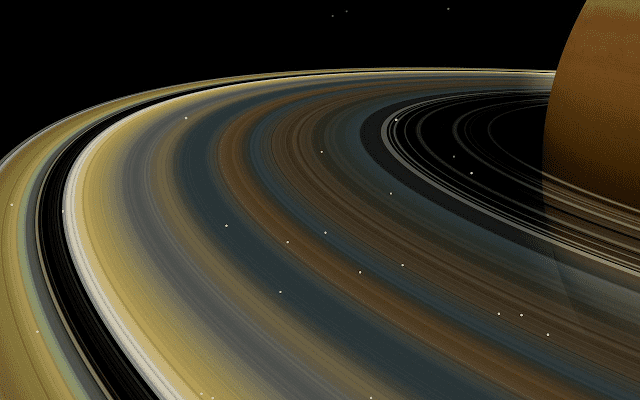Surrounding the gas giant are stretches of distinct rings comprised of fine matter orbiting the planet. These rings are absolutely huge and help make Jupiter a dazzling sight. For centuries, since Galileo first spotted the rings, to present day when NASA’s probes sweep past them, scientists have been fascinated by how these form. To this day, there are many things we don’t know about Saturn’s rings. For instance, one recent study turned a long held paradigm upside down. One of Saturn’s ring, which is very opaque and bright seems to have played an optical illusions all along. It is in fact much lighter than previously though — as little as a seventh of the mass it appears to have.
The rings of Saturn are the most extensive planetary ring system of any planet in the Solar System. There are 7 hola hoops in total, named alphabetically outwards from the planet D, C, B, A, F, G, and E. The matter that constitute the rings can be as large as a car or as small as a grain of sand. The rings stretch 464,000 km (over 288,000 miles) from the top of Saturn’s atmosphere, but are only tens of meters thick!
Some of the rings are close together. Others have large gaps between them. And concerning mass, this has always proven difficult to estimate for each ring. You can’t put the rings on a scale which revolve around a planet 700 times larger than Earth. Instead, scientists use something called spiral density waves to gauge how massive the rings are. These are essentially ripples that form like a traffic jam as ring particles get jostled by Saturn’s moons. If there’s a change in density, then the ripples change too and using this link it is possible to estimate how massive each ring is. The brightest and most opaque sections were assumed to be the largest, while those that are dimer and less opaque are thought to be less dense.
Now, ring B is a bit special since it’s a very complex structure. It’s the most opaque ring in the solar system (Neptune and Jupiter also have rings), and based on this, previous estimates suggested ring B should be twice as massive as Saturn’s moon Mimas.
Cassini left Earth in 1997 and arrived at Saturn seven years later, in 2004. The spacecraft has been orbiting the planet since then, monitoring the planet, its moon and rings with sophisticated cameras and sensory equipment. A new analysis made by Cassini was able to probe much subtler density waves. What happened is that although the spacecraft probed both bright and darker regions of Saturn’s rings, it found that these regions’ density was more or less the same. The B ring holds just half to a seventh of the mass it appears to.

Visible-light comparison of Saturn’s B ring (left) and A ring (right). These are separated by the Cassini division. Image: NASA
“At present it’s far from clear how regions with the same amount of material can have such different opacities. It could be something associated with the size or density of individual particles, or it could have something to do with the structure of the rings,” said Matthew Hedman, lead author and a Cassini participating scientists.
We’ve all been deceived by an illusion, it seems.
“Appearances can be deceiving,” noted co-investigator Phil Nicholson of Cornell University in Ithaca, New York. “A good analogy is how a foggy meadow is much more opaque than a swimming pool, even though the pool is denser and contains a lot more water.”
Even so, Ring B is still the most massive ring in the solar system, the astronomers report in the journal Icarus. But now that we have a more accurate picture of Saturn’s rings, we can piece together the age and origin of Saturn’s rings.











